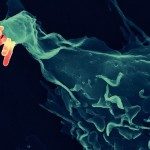Link to Pubmed [PMID] – 19622097
Cell. Microbiol. 2009 Oct;11(10):1462-70
The type III secretion system (T3SS) is a sophisticated molecular machinery of Gram-negative bacteria used to ‘inject’ (translocate) bacterial proteins (effectors) into eukaryotic cells. For this, the T3SS has to assemble into a multiprotein complex, which is constituted of distinct parts; a basal body spanning the two bacterial membranes connected with a cytoplasmic bulb, an attached needle structure resembling a molecular syringe, and a distal needle tip structure that re-organizes into a ‘translocon’, which is a protein complex that inserts into the host cellular membrane. Upon engaging with eukaryotic cells, the T3SSs perform ‘single-step’ translocation of bacterial effector proteins across three membranes (two bacterial and one eukaryotic). Since the formulation of the major concepts of the T3SS about 15 years ago, imaging has been a major ingredient for elucidating the T3SS structure and function. Direct observation of molecular events in the context of cells will remain a key feature for better understanding of T3SS structure, regulation and function. In this review we describe how light and electron microscopy have been used to shed light on the processes of maturation and activity of the T3SS. Furthermore, we highlight recent imaging innovations with the potential to provide better insight into the T3SS structure and function.

